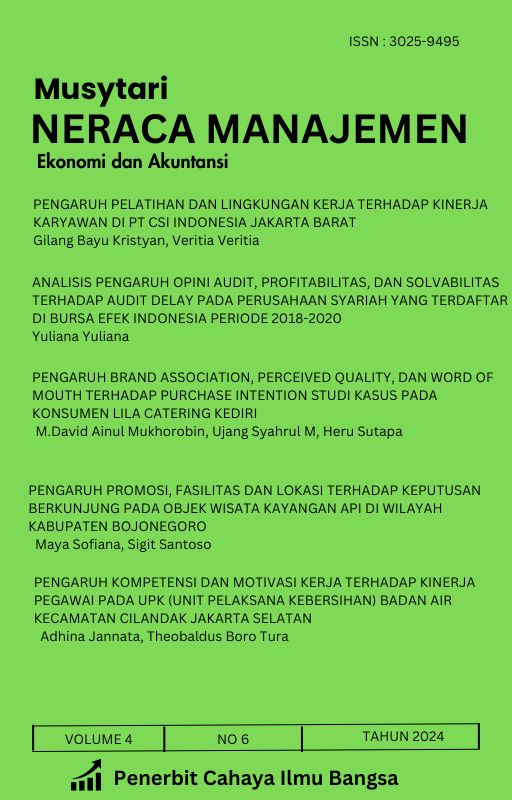PENGARUH PERCEIVED SECURITY DAN EASE OF USE TERHADAP REPURCHASE INTENTION PELANGGAN WANITA MILLENIALS PADA E-COMMERCE SHOPEE
Published 2025-06-14
Keywords
- Ease of Use, E-Commerce, Generasi Millennials, Loyalitas Pelanggan, Perceived Security, Repurchase Intention, Shopee.
How to Cite
Abstract
Penelitian ini bertujuan untuk mengkaji pengaruh perceived security dan ease of use terhadap repurchase intention pada pelanggan wanita Generasi Millennials pengguna e-commerce Shopee. Pendekatan yang digunakan adalah kuantitatif dengan desain penelitian kausal, melibatkan 200 responden wanita berusia 20–39 tahun yang aktif berbelanja di Shopee. Analisis data dilakukan melalui uji validitas, reliabilitas, regresi linear berganda, ANOVA, dan uji normalitas. Hasil menunjukkan bahwa kedua variabel independen tersebut berpengaruh positif dan signifikan terhadap repurchase intention, dengan kontribusi sebesar 33,6% (R Square = 0,336). Ease of use memiliki pengaruh yang lebih dominan (β = 0,498) dibandingkan perceived security (β = 0,148). Namun, hasil uji normalitas menunjukkan bahwa data tidak berdistribusi normal, sehingga penelitian lanjutan disarankan mempertimbangkan transformasi data atau metode non-parametrik. Temuan ini menekankan pentingnya kemudahan penggunaan dan persepsi keamanan dalam mendorong niat pembelian ulang serta memberikan implikasi strategis bagi peningkatan loyalitas pelanggan di platform e-commerce seperti Shopee.
References
- Chen, Y., & Barnes, S. (2007). Initial trust and online buyer behaviour. Industrial Management & Data Systems, 107(1), 21–36. https://doi.org/10.1108/02635570710719034
- Davis, F. (1989). Perceived usefulness, perceived ease of use, and user acceptance of information technology. MIS Quarterly, 13(3), 319–340.
- Eid, M. (2011). Determinants of E-commerce Customer Satisfaction, Trust, and Loyalty in Saudi Arabia. Ournal of Electronic Commerce Research, 12(1), 78–93.
- Flavia’n, C., & Guinali’u, M. (2006). Consumer Trust, Perceived Security and Privacy Policy Three Basic Elements of Loyalty to a Web Site. Industrial Management & Data Systems, 106(5), 601–620.
- Gefen, Karahanna, & Straub. (2003). Trust and TAM in Online Shopping: An Integrated Model. MIS Quarterly, 27(1), 51. https://doi.org/10.2307/30036519
- Megantara, I. M. T., & Suryani, A. (2016). Penentu Niat Pembelian Kembali Tiket Pesawat Secara Online Pada Situs Traveloka.Com. E-Jurnal Manajemen Unud, 5(9), 5783–5810.
- Nofiyanti, & Wiwoho, G. (2020). Pengaruh Perceived Usefulness dan Perceived Value Terhadap Online Repurchase Intention pada Marketplace Shopee di Kecamatan Kebumen dengan Customer Satisfaction sebagai Variabel Intervening. Urnal Ilmiah Mahasiswa Manajemen, Bisnis Dan Akuntansi, 2(2), 281–290.
- Ruslim, T. S. (2024). The Effect of Security and Perceived Ease of Use on Repurchase Intention in Online Marketplace Consumers with Trust as Mediation (Case: Marketplace “T” in Jakarta). Primanomics : Jurnal Ekonomi & Bisnis, 22(3), 243–254. https://doi.org/10.31253/pe.v22i3.3210
- Venkatesh, Thong, & Xu. (2012). Consumer Acceptance and Use of Information Technology: Extending the Unified Theory of Acceptance and Use of Technology. MIS Quarterly, 36(1), 157. https://doi.org/10.2307/41410412

